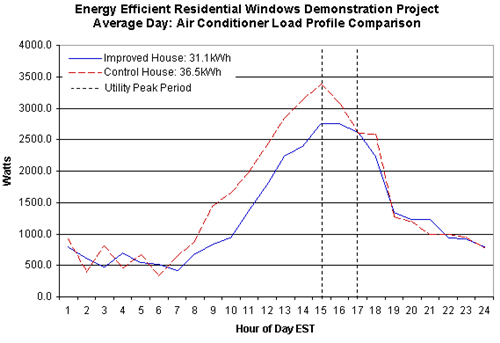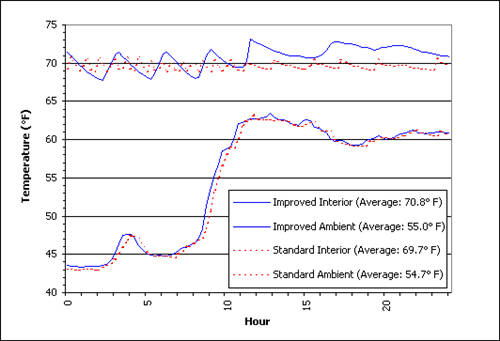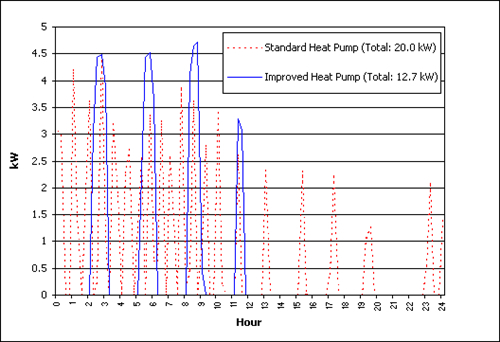
![]()
![]() Preliminary Performance Data
Preliminary Performance Data
Updated 3/13/00
A 17-day period in September 1999 was used to estimate the summer (cooling) savings of the improved house. During this 17-day period, both houses were unoccupied, and the average ambient temperature was 79.5°F. The cooling set point at the houses were set so that each house held approximately the same interior temperature. Over the 17-day span, the average interior temperature of the standard house was 76.1°F and the average interior temperature of the improved house was 75.8°F. Although very similar thermostat settings were used, measured interior temperatures showed evidence of improved comfort in the improved home during the hottest part of the summer afternoons.
Comparison of the combined condenser and AHU power for the 17-day period showed that the improved home used 14.7% less cooling energy than the standard home. As shown in Figure 1 below, the profile of the AC savings was strongly a function of the time of day, with the largest demand reductions between 7 AM and 5 PM EST. The experimental results from the project demonstrate that the improved windows have the potential to reduce the peak cooling energy demand in Florida houses while producing energy savings for the consumer.
Performance of the improved windows during the heating season was conducted on January 28, 2000 - one of the coldest days of Florida's mild winter season. The average ambient temperature for the 24-hour period was 55°F with a low of 43°F (see Figure 2). Although both houses were occupied during this period, the interior temperature in the houses was, on average, within 1.1°F (the standard house averaged 69.7°F and the improved house averaged 70.8°F for the 24-hour period).

Figure 1: Unoccupied Cooling Air Conditioner Consumption Comparison
During the 24-hour period, although both houses were heating, the improved house's heat pump consumed 36.4% less energy. This is made more impressive by the fact that the interior temperature in the improved house was also higher. Figure 3 shows that while the standard house's heat pump cycled on-and-off all day, once the ambient temperature rose above 60°F, the improved house's heat pump did not need to come on again to maintain the interior temperature. Thus, it appears that the increased R-value of the double-paned, thermally-broken improved windows aided in insulating the improved house.

Figure 2: January 28 Temperature Comparison
During the early morning period (1AM - noon), the improved insulating quality of the better glass was also helpful in decreasing the number of times that the improved house's heat pump had to cycle on. While the standard house's heat pump cycled 14 times, the improved house's cycled only 4.

Figure 3: January 28 Heat Pump Comparison
